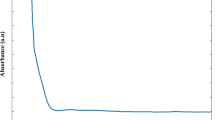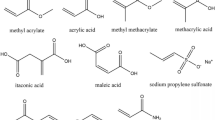Abstract
Various proportions of 4,4′-oxybisbenzoic acid (OBBA) were incorporated to obtain the spinning solution of sulfonated polyoxadiazole (SPOD) copolymer through copolymerization in oleum. And the sulfonated fibers were prepared from the solution by using wet spinning approaches. The chemical structures of the fibers were characterized using Fourier transform infrared spectroscopy (FTIR) and elemental analyzer. The results indicated that sulfo groups were successfully introduced into the macromolecular chain. And the flame retardancy of the SPOD fibers was evaluated by limiting oxygen index, UL-94 and microscale combustion calorimeter tests, showing that flame-retardant properties could be significantly enhanced. And the thermal decomposition and flame-retardant mechanism were studied through various analytical methods. And thermogravimetric (TG) analyzer and scanning electron microscope results showed that the incorporation of OBBA would help fibers form more compact carbon residue. X-ray photoelectron spectroscopy and TG-FTIR results revealed that sulfur element increased carbon residue rate in the condensed phase and some converted into SO2 in the gas phase. Py-GC/MS results showed that thermal decomposition happened at oxadiazole rings and the introduction of OBBA did not alter the decomposition mechanism of POD essentially.









Similar content being viewed by others
References
Wu TY, Sheu RB, Chen Y. Synthesis and optically acid-sensory and electrochemical properties of novel polyoxadiazole derivatives. Macromolecules. 2004;37:725–33.
Udayakumar D, Adhikari AV. Synthesis and characterization of fluorescent poly(oxadiazole)s containing 3, 4-dialkoxythiophenes. Opt Mater. 2007;29:1710–8.
Ipate AM, Hamciuc C, Homocianu M, Musteata VE, Nicolescu A, Bruma M, Belomoina N. Highly fluorinated poly (1,3,4-oxadiazole-ether)s. structural, optical and dielectric characteristics. J Polym Res. 2015;22:1–17.
Yasujima H, Murakami M, Yoshimura S. Electrical and thermal properties of new pyrographite films based on a condensation polymer, polyoxadiazole. Appl Phys Lett. 1986;49:499–501.
Brown PA, Chan JW, Cobb MW, Williams SR. Preparation of sulfonated naphthalene polyoxadiazoles polymers. US Patent Application 20130338335; 2013.
Harmer MA, Williams SR, Cobb MW. Insulating material containing poly (phenylene-1,3,4-oxadiazole). US Patent Application 20140184371; 2014.
Shioya M, Shinotani K, Takaku A. Carbonization behavior of polyoxadiazole fibers and films. J Mater Sci. 1999;34:6015–25.
Frazer AH, Sweeny W, Wallenberger FT. Poly(1,3,4-oxadiazoles): a new class of polymers by cyclodehydration of polyhydrazides. J Polym Sci Part A. 1964;2:1157–69.
Iwakura Y, Uno K, Hara S. Poly-1,3,4-oxadiazoles. I. Polyphenylene-1,3,4-oxadiazoles. J Polym Sci Part A. 1965;3:45–54.
Schulz B, Bruma M, Brehmer L. Aromatic Poly(1,3,4-Oxadiazole)s as advanced materials. Adv Mater. 1997;9:601–13.
Bova VG, Mikhajlova MP, Sugak VN, Tikhonov IV, Makarova RA, Kuznetsov VA, Durakovskij AP, Kharchenko EF. Fire-resistant fabric. RU Patent 2211263; 2003.
Nauchno V. Werkwijze voor het bereiden van oxadiazolverbindingen, werkwijze voor het vervaardigen van vezels en zo gevormde vezels. NL Patent 7502905; 1975.
Schiff KL, Füner AV, Strehl P, Schübel-Hopf U, Ebbinghaus D, Pat.-Anwälte, 8000 München. Polyarylen-1,3,4-oxadiazole, Verfahren zur Herstellung derselben und Verfahren zur Herstellung von Polyoxadiazolfasern auf deren Basis. DE Patent 2408426; 1974.
Cobb MW, Marchione AA, Mcminn JH, Williams SR. Preparation of sulfonated polyoxadiazole polymers. US Patent Application 20130217854; 2013.
Cobb MW, Williams SR, Zhu R. Flame resistant spun staple yarns made from blends of fibers derived from sulfonated polyoxadiazole polymers. US Patent Application 20130210306; 2013.
Gomes D, Roeder J, Ponce ML, Nunes SP. Single-step synthesis of sulfonated polyoxadiazoles and their use as proton conducting membranes. J Power Sources. 2008;175:49–59.
Hamciuc C, Hamciuc E, Bruma M, Klapper M, Pakula T, Demeter A. New aromatic polyethers containing phenylquinoxaline and 1,3,4-oxadiazole rings. Polymer. 2001;42:5955–61.
Yang YY, Kong WB, Wang YC, Cai XF. Synthesis of tris (phenoxy) trifluorocyclotriphosphazenes and study of its effects on the flammable, thermal, optical, and mechanical properties of bisphenol-A polycarbonate[J]. J Therm Anal Calorim. 2015;122:805–16.
Hu S, Song L, Pan HF, Hu Y. Effect of a novel chitosan-based flame retardant on thermal and flammability properties of polyvinyl alcohol. J Therm Anal Calorim. 2013;112:859–64.
Ellzey KA, Ranganathan T, Zilberman J, Coughlin EB, Farris RJ, Emrick T. Deoxybenzoin-based polyarylates as halogen-free fire-resistant polymers. Macromolecules. 2006;39:3553–8.
Wang DY, Song YP, Lin L, Wang XL, Wang YZ. A novel phosphorus-containing poly (lactic acid) toward its flame retardation. Polymer. 2011;52:233–8.
Hu WZ, Zhan J, Hong NN, Hull TR, Stec AA, Song L, Wang J, Hu Y. Flame retardant polystyrene copolymers: preparation, thermal properties, and fire toxicities. Polym Adv Technol. 2014;25:631–7.
Perepelkin KE, Malan’ina OB, Basok MO, Makarova RA, Oprits ZG. Thermal degradation of thermostable aromatic fibres in air and nitrogen medium. Fibre Chem. 2005;37:196–8.
Qi YX, Wu WH, Han LJ, Qu HQ, Han X, Wang AQ, Xu JZ. Using TG-FTIR and XPS to understand thermal degradation and flame-retardant mechanism of flexible poly (vinyl chloride) filled with metallic ferrites. J Therm Anal Calorim. 2016;123:1263–71.
Cheng CH, Lehmann J, Thies JE, Burton SD, Engelhard MH. Oxidation of black carbon by biotic and abiotic processes. Org Geochem. 2006;37:1477–88.
Xie ZW, Wang LP, Wang XF, Huang L, Lu Y, Yan JC. Influence of high temperature annealing on the structure, hardness and tribological properties of diamond-like carbon and TiAlSiCN nanocomposite coatings. Appl Surf Sci. 2011;258:1206–11.
Kovtyukhova NI, Ollivier PJ, Martin BR, Mallouk TE, Chizhik SA, Buzaneva EV, Gorchinskiy AD. Layer-by-layer assembly of ultrathin composite films from micron-sized graphite oxide sheets and polycations. Chem Mater. 1999;11:771–8.
Geng DS, Yang SL, Zhang Y, Yang JL, Liu J, Li RY, Sham TK, Sun XL, Ye SY, Knights S. Nitrogen doping effects on the structure of graphene. Appl Surf Sci. 2011;257:9193–8.
Snis A, Matar SF. Electronic density of states, 1s core-level shifts, and core ionization energies of graphite, diamond, C3N4 phases, and graphitic C11N4. Phys Rev B. 1999;60:10855–63.
Kozlowski C, Sherwood PMA. X-ray photoelectron-spectroscopic studies of carbon-fibre surfaces. Part 5: The effect of pH on surface oxidation. J Chem Soc Farad Trans 1 1985;81:2745–56.
Peña JM, Allen NS, Edge M, Liauw CM, Valange B. Studies of synergism between carbon black and stabilisers in LDPE photodegradation. Polym Degrad Stabil. 2001;72:259–70.
Zhang SW, Zeng MY, Li JX, Li J, Xu JZ, Wang XK. Porous magnetic carbon sheets from biomass as an adsorbent for the fast removal of organic pollutants from aqueous solution. J Mater Chem A. 2014;2:4391–7.
Liu FJ, Sun J, Sun Q, Zhu LF, Wang L, Meng XJ, Qi CZ, Xiao FS. High-temperature synthesis of magnetically active and SO3H-functionalized ordered mesoporous carbon with good catalytic performance. Catal Today. 2012;186:115–20.
Beamson G, Briggs D. High resolution XPS of organic polymers. The scienta ESCA300 database. Chichester: Wiley; 1992.
Dong CH, Lu Z, Zhu P, Zhang FJ, Zhang X. Combustion behaviors of cotton fabrics treated by a novel guanidyl- and phosphorus-containing polysiloxane flame retardant. J Therm Anal Calorim. 2015;119:349–57.
Acknowledgements
The authors sincerely acknowledge the device support from State Key Laboratory of Polymer Materials and Engineering and every researcher’s helps and efforts in completing the research.
Author information
Authors and Affiliations
Corresponding authors
Rights and permissions
About this article
Cite this article
Yan, X., Li, Z., Zhou, W. et al. Study of the thermal decomposition and flame-retardant mechanism of sulfonated polyoxadiazole fibers. J Therm Anal Calorim 126, 1301–1311 (2016). https://doi.org/10.1007/s10973-016-5752-8
Received:
Accepted:
Published:
Issue Date:
DOI: https://doi.org/10.1007/s10973-016-5752-8




